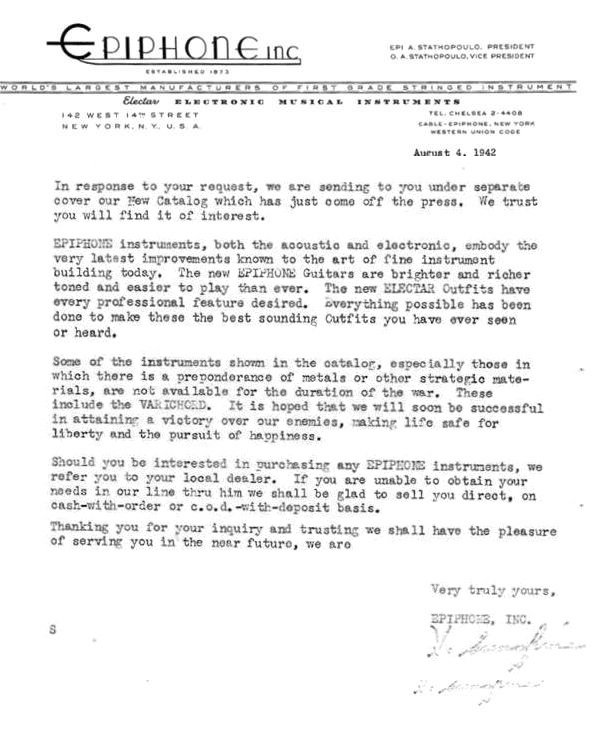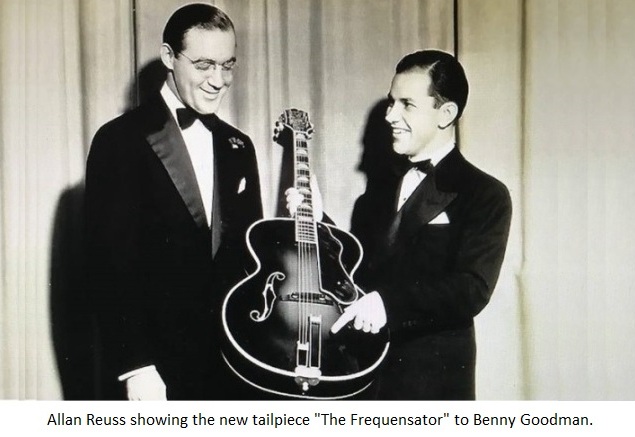NOTE: Epiphone guaranteed “All models for the life of the instrument” (cat. 1932), but “metal and other parts that recieve wear excepted” (cat. 1934). Since they don’t last such a long period, many of the historic guitars are most likely not equipped with their original tailpieces anymore. Therefore the pictures below only show types of tailpieces Epiphone used over the years. They don’t necessarily show whether they originaly belong to the instrument they are on.
References :
Felix Wiedler, NY Epi Reg
Jim Fisch & L.B. Fred, The House of Stathopoulo, 1996, pp. 70-74
Epiphone used over the years six different tailpieces for their achtop guitars. The trapeze tailpiece was used on all Masterbilt models until the mid 1930’s. The plating was gold on the uper-end guitars and nickel on the lesser instruments. In the early 1930’s, the strings were attached to the crossbar with the ball ends toward the neck and wrapped over the bar.

By 1934, the strings were attached to the crossbar with the ball ends pointed toward the bottom of the instrument and the strings did not wrap over the crossbar. One example in our database is engraved. It is on a De Luxe with checkerboard binding, of which we have also only one example in our database. More detailed info on Epiphone trapeze tailpieces, see: Trapeze tailpiece evolution 1931–1956
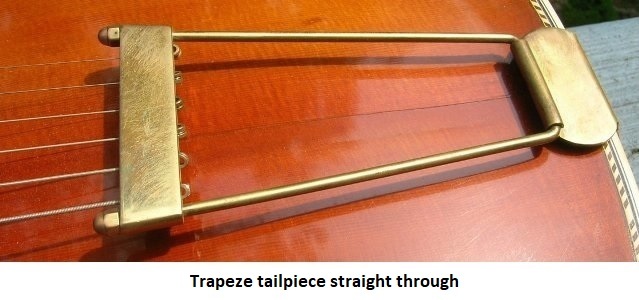
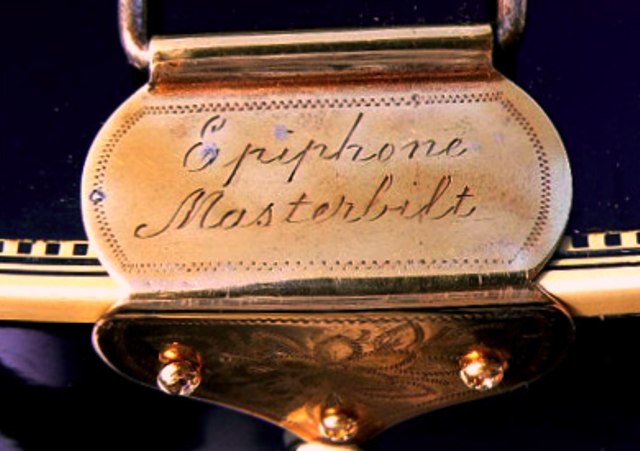
The December 1935 Metronome magazine ad which introduced the Emperor, shows both the Emperor and the Super De Luxe with a tailpiece very similar in design to the style used on early Gibson Super 400 guitars see picture. The Epiphone tailpiece was a flat plate style with two side-pieces connecting the crossbar and the securing plate. The center ornamentation resembled an arrow, with the point being attached to a smaller crossbar parallel to and about one inch below the actual crossbar. This tailpiece is very rare, but is presumed to have gone into production because it appears in no fewer than three Metronome ads and many catalog photos.

In 1935/36, another tailpiece appeared on the Emperor, De Luxe, Broadway and Triumph. The 1936 Epiphone catalog referred to this as “the new compensating tailpiece”, though the intended means of compensation is unclear (perhaps it was designed to equalize tension). It was a large, flat plate with four cut-out rectangles on the extension, of which three were side by side and parallel lengthwise and the fourth was parallel to the crossbar. The plating was gold on the Emperor, De Luxe and Broadway, and nickel on the Triumph.
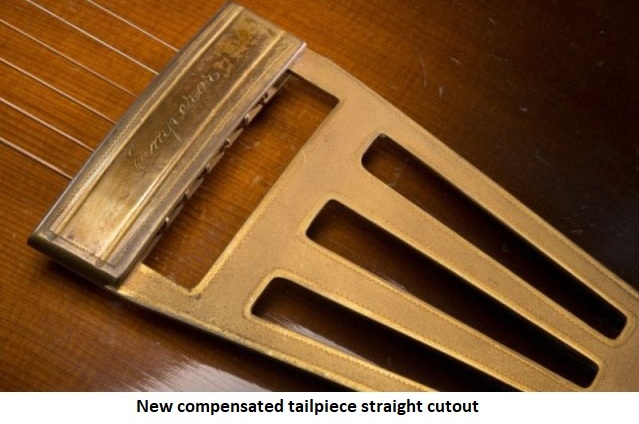
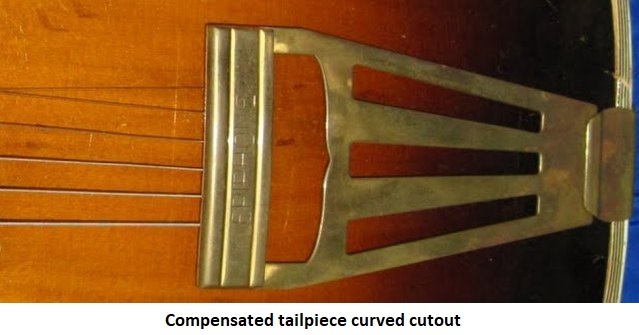
In a Down Beat magazine ad from September 1937, a radical new tailpiece called the Frequensator, was introduced. see patent The idea behind the design was to provide compensation between the tremble and bass strings, and the word “frequensator” was a contraction of the words “frequency” and “compensator”. The Down Beat ad promises “Greater Clarity, “Truer Tone” and “Eliminates Deadspots”.
The Frequensator consisted of two separate extensions of unequal lengths; a shorter one of 2,5 inch for the bass strings and a longer one of 5,75 inch for the tremble strings. The bass extension allowed longer strings lengths for the bass strings resulting in deeper response for these strings, and the longer tremble extension provided a more brilliant tone in these strings. A bent metal plate anchored the unit to the guitar. This tailpiece was used on the Emperor, De Luxe, Broadway and Triumph and also appeared on the Devon introduced in 1951.

All higher-end acoustic and electric archtops were equipped with the Frequensator tailpiece – designed by Epiphone employee Herb Sunshine – and introduced in 1937. Although the design was patented by July 19, 1938 the units kept being stamped “Pat. pending” (Wiedler : close-up # 30)
April 2014 Wiedler wrote us: “The trapeze tailpiece stamped “EPIPHONE” was used on some electric archtops c. 1941-42 before electrics were apparently discontinued during the war. Then this stamped tailpiece appears briefly on some c.1942-43 Olympics, just before Epiphone started to use a metal-saving tailpiece with rosewood crossbar (to comply with war-time regulations – see: letter Herb Sunshine below). The wooden crossbar can be found on some archtop models as late as c. early 1947.”
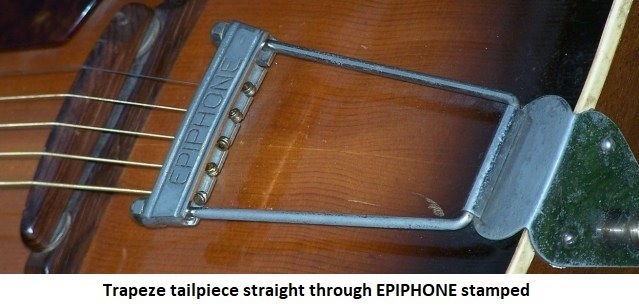
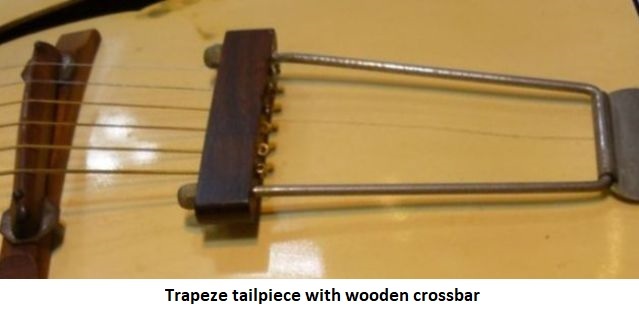
VIBROLA VIBRATO UNIT
One of the first mechanical vibrato units was the Vibrola, invented by Doc Kauffman. It was filed for patent in 1929 and granted in 1932 (patent US1839395 A). Epiphone offered the Vibrola to the general public as an option on some archtop guitars in their 1934 catalog. Epiphone sold the Vibrola as an aftermarket option as well. See also : Wiedler close-up # 01

